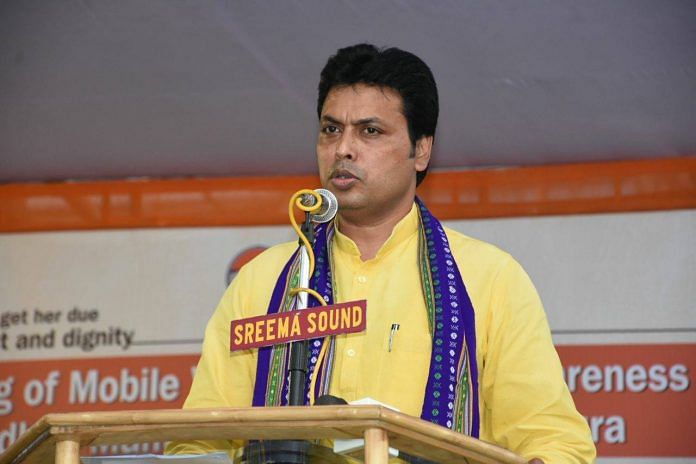The BJP has begun to leverage every bit of its organisational capacity across the country. The party uses its leaders from the northeastern states to campaign during elections in other parts of the country.
The Karnataka assembly election was being seen as a test case for the efficacy of the Bharatiya Janata Party’s (BJP) campaign outside its traditional strongholds in the Hindi-speaking states. Most discussions on the BJP’s campaign stress on the role of money power, religious polarisation and star campaigners. An interesting insight into the BJP’s campaign can, however, be obtained if we explore it from a northeastern perspective.
At the time of elections in the northeast, the BJP invites its party members from the rest of the country to campaign there. In particular, it enlists northeastern migrants from the BJP strongholds in the “mainland” to spread the party’s message in their own states. Tripura Chief Minister Biplab Deb is an example.
The BJP also uses its leaders from northeastern states to campaign during elections in other parts of the country. In the run-up to the Karnataka elections, Nagaland Post reported that the deputy chief minister, two other ministers, and senior BJP leaders from Nagaland visited Bengaluru to campaign among “more than 8,000” people from Nagaland. They spent about three days in Bengaluru. A video available on the social media shows one of the BJP ministers addressing a small crowd in NAP Hindi.
The Morung Express reported that the Nagaland BJP organised a Moatsu Mong festival on May 5 at the Radisson Blu Hotel in Bengaluru and interacted with students. According to another Nagaland Post report, the Naga leaders, including both Baptists and Catholics, met “with Christian leaders and the Mount Zion Pentecostal International Church community at R.K. Puram, Bengaluru, which was attended by Bishop Francis Jackson, who is also the chairman of Karnataka Christian Federation”.
The contingent from Nagaland was not the only one from the northeast. BJP delegations from other northeastern states had also camped in the city. These delegations got together in a North East Samabesh held in Bengaluru on May 6. The Congress does not seem to have invited its northeastern leaders and cadre to campaign in Karnataka.
A few thousand Nagas scattered across Bengaluru and other cities of Karnataka can hardly make a difference to the outcome of elections in either Nagaland or Karnataka. Incidentally, the BJP had also engaged some of the groups mentioned above in the run-up to the February 2018 election in Nagaland. Conventional wisdom suggests that spending so much of resources to repeatedly engage a small and scattered group of voters does not make much sense.
Method in madness
There is a method in the madness though. First, the BJP has begun to leverage every bit of its organisational capacity across the country. Since states do not go to polls simultaneously, and the parliamentary elections are staggered, it can rope in Nagaland leaders to campaign in Karnataka and vice versa.
Second, the seemingly wasteful campaigns instil a sense of belonging and responsibility in its newly recruited cadre and leaders and enmesh them in a web of personal ties with cadre elsewhere in the country. It also facilitates instrumental learning across state units.
Third, these campaigns also help the party to repeatedly engage potential voters. In the present case, overlapping pools of voters were approached first before the Nagaland election and then again before the Karnataka election.
Elections held in Karnataka and in a few of the northeastern states over the past six months offer another insight into the BJP’s campaigns. It would be misleading to judge the fortunes of the BJP by looking at just its overt campaign in the months ahead of the elections. The party rolls out a massive campaign barely a few weeks before the elections to complement the regular outreach to select pockets of voters. Technology, particularly social and digital media, allows it to rapidly build momentum just before the elections. Restricting the duration of the high-decibel overt campaign not only helps guard against voter fatigue as it would be difficult to sustain a shrill campaign over a long period, but also cuts down costs and allows a focused use of star campaigners.
The BJP seemed distracted ahead of this year’s elections in Nagaland. However, in the last fortnight before the election, it rolled out an unprecedented (newspaper advertisement) campaign, among other things. The blitzkrieg built upon a long-term, low-key campaign targeting a village here and a tribe there. This campaign was conducted almost entirely below the radar of the national media and even the local media did not take it seriously. In the end, the party won a record number of seats in the teeth of the opposition by the Baptist Church and joined the coalition government from a position of strength.
The above observations raise several questions, which are crucial to understand if and how the Opposition can challenge the BJP in the forthcoming parliamentary elections.
Do other parties or alliances have the ability to pool pan-Indian resources?
- Can the BSP, send its cadres and second-tier leaders to campaign for the JDS before the Lok Sabha elections in Karnataka and expect the JDS to reciprocate in Uttar Pradesh?
- Can the Congress send its Gujarat unit to campaign in Himachal Pradesh and then invite the Himachal unit to campaign in Gujarat?
- Do other parties have the capacity to rapidly scale up campaigns weeks ahead of elections?
- Can the Congress, increase the momentum towards the end unlike in Gujarat and Karnataka, where it lost steam just when the BJP began its final campaign?
- Do other parties have the resources to remain in regular contact with strategically placed groups of voters?
- Can the Congress, hope that someone would continue to engage voters on its behalf during the lean season and, thereby, conserve resources for the last lap?
Vikas Kumar teaches Economics at Azim Premji University, Bengaluru and researches the history and politics of the northeast.



